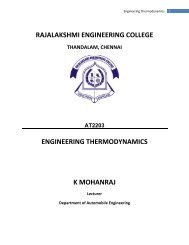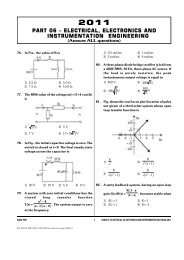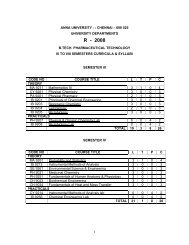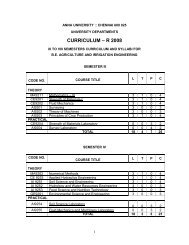Interview Questions in Core Java - Index of
Interview Questions in Core Java - Index of
Interview Questions in Core Java - Index of
You also want an ePaper? Increase the reach of your titles
YUMPU automatically turns print PDFs into web optimized ePapers that Google loves.
You create an abstract class when you want to manipulate a set <strong>of</strong> classes through a common <strong>in</strong>terface. All<br />
derived-class methods that match the signature <strong>of</strong> the base-class declaration will be called us<strong>in</strong>g the<br />
dynamic b<strong>in</strong>d<strong>in</strong>g mechanism.<br />
An abstract method is an <strong>in</strong>complete method. It has only a declaration and no method body. Here is the<br />
syntax for an abstract method declaration: abstract void f();<br />
20) How can you force all derived classes to implement a method present <strong>in</strong> the base class?<br />
Creat<strong>in</strong>g and implement<strong>in</strong>g an <strong>in</strong>terface would be the best way for this situation. Just create an <strong>in</strong>terface<br />
with empty methods which forces a programmer to implement all the methods present under it.<br />
Another way <strong>of</strong> achiev<strong>in</strong>g this task is to declare a class as abstract with all its methods abstract.<br />
21) What is the difference between an Applet and an Application?<br />
1. Applets can be embedded <strong>in</strong> HTML pages and downloaded over the Internet whereas Applications have<br />
no special support <strong>in</strong> HTML for embedd<strong>in</strong>g or download<strong>in</strong>g.<br />
2. Applets can only be executed <strong>in</strong>side a java compatible conta<strong>in</strong>er, such as a browser or appletviewer<br />
whereas Applications are executed at command l<strong>in</strong>e by java.exe or jview.exe.<br />
3. Applets execute under strict security limitations that disallow certa<strong>in</strong> operations(sandbox model security)<br />
whereas Applications have no <strong>in</strong>herent security restrictions.<br />
4. Applets don't have the ma<strong>in</strong>() method as <strong>in</strong> applications. Instead they operate on an entirely different<br />
mechanism where they are <strong>in</strong>itialized by <strong>in</strong>it(),started by start(),stopped by stop() or destroyed by destroy().<br />
22) <strong>Java</strong> says "write once, run anywhere". What are some ways this isn't quite true?<br />
Any time you use system calls specific to one operat<strong>in</strong>g system and do not create alternative calls for<br />
another operat<strong>in</strong>g system, your program will not function correctly.<br />
Solaris systems and Intel systems order the bits <strong>of</strong> an <strong>in</strong>teger differently. (You may have heard <strong>of</strong> little<br />
endian vs. big endian)<br />
If your code uses bit shift<strong>in</strong>g, or other b<strong>in</strong>ary operators, they will not work on systems that have opposide<br />
endianism.<br />
23) Describe java's security model.<br />
<strong>Java</strong>'s security model is one <strong>of</strong> the most <strong>in</strong>terest<strong>in</strong>g and unique aspects <strong>of</strong> the language. For the most part<br />
it's broken <strong>in</strong>to two pieces: the user adjustable security manager that checks various API operations like file<br />
access, and the byte code verifier that asserts the validity <strong>of</strong> compiled byte code.<br />
public abstract class SecurityManager java.lang.SecurityManager is an abstract class which different<br />
applications subclass to implement a particular security policy. It allows an application to determ<strong>in</strong>e<br />
whether or not a particular operation will generate a security exception.<br />
24) What is the difference between a Vector and an Array. Discuss the advantages and disadvantages<br />
<strong>of</strong> both?<br />
The vector conta<strong>in</strong>er class generalizes the concept <strong>of</strong> an ord<strong>in</strong>ary C array. Like an array, a vector is an<br />
<strong>in</strong>dexed data structure, with <strong>in</strong>dex values that range from 0 to one less than the number <strong>of</strong> elements<br />
conta<strong>in</strong>ed <strong>in</strong> the structure. Also like an array, values are most commonly assigned to and extracted from the<br />
vector us<strong>in</strong>g the subscript operator. However, the vector differs from an array <strong>in</strong> the follow<strong>in</strong>g important<br />
respects:<br />
The size <strong>of</strong> the vector can change dynamically. New elements can be <strong>in</strong>serted on to the end <strong>of</strong> a vector, or<br />
<strong>in</strong>to the middle. It is important to note, however, that while these abilities are provided, <strong>in</strong>sertion <strong>in</strong>to the<br />
middle <strong>of</strong> a vector is not as efficient as <strong>in</strong>sertion <strong>in</strong>to the middle <strong>of</strong> a list.
















